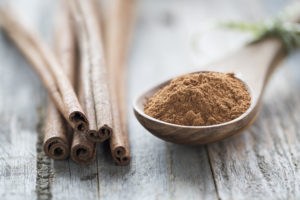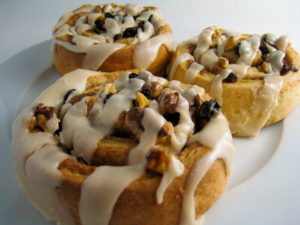
Well the holiday season is upon us. Our calendars and days are now filled with shopping, travel, and social gatherings with friends, family, and loved ones. As the temperature outside turns cold, we turn to many of our favorite treats to fill our bellies and help keep us warm. Our mouths water as we think about all of the delectable items that line our kitchens and tables. I can picture it now… a warm fire keeping the room nice and toasty, glass of wine in hand, friends and relatives conversing and catching up and of course, avoiding awkward conversations with Uncle Gary. All while hovering around various piles of unknown cheeses, meats, and delicious stacks of sweets. And If you’re lucky, you may even find a warm, sticky stack of homemade cinnamon buns. As it turns out, these may be just the thing to reach for to help burn off some of that unwanted extra “padding” that comes with all of those holiday favorites.
What’s that you say? Cinnamon buns burn fat? Well before you go eating the whole tray, it’s not really the cinnamon buns themselves that may help burn fat, but the cinnamon for which they are named. It tastes great, you can use it in all sorts of dishes, and it accelerates fat loss. I’m a fan of all of those things. Now, you probably find yourself asking, where can I learn more about this awesome spice? Well, look no further my friend, I am about to lay enough cinnamon-spiced knowledge on you to guarantee that you can bore your friends and family to tears with your cinnamon information stream at your holiday gathering. You’ll be less popular than Uncle Gary.
Cinnamon contains a compound known as cinnamaldehyde. Cinnamaldehyde is a naturally occurring chemical found in the bark of cinnamon trees that gives cinnamon both its characteristic flavor and odor. A recent study shows that cinnamaldehyde can even help burn fat by increasing metabolism and your body’s ability to breakdown fat! I know, it’s pretty magical. Now before you go running around stabbing cinnamon trees with a spout, there’s a few things you should know. Primarily that you have to fly to Sri Lanka, which is expensive but totally worth it since it’s a beautiful tropical island in the Indian Ocean. And you can even stay at a place called Cinnamon Bey, which looks like this picture I found of it on the interweb. Pretty sweet, huh? (See what I did there!)

Anyway, the purest source of cinnamon-derived cinnamaldehyde is the Ceylon Cinnamon tree (say that several times fast while jamming a sticky bun in your face!). Also known as, the “True” Cinnamon tree, which is named after the historical moniker of its native country, Sri Lanka (formerly Ceylon). The country still produces and exports up to 90% of the world’s true cinnamon. The other 10% comes from Seychelle and Madagascar, which are equally far and equally awesome as travel destinations. However, there are six species of cinnamon sold commercially around the world. So If you prefer the regular stuff found cheaply at most grocery stores, then you will have to head to China or Southeast Asia for the most common variant, cassia, which is considered to be less, um, “Top-Shelf”.
The cassia variant is cultivated on a larger scale and is coarser than ceylon cinnamon. It also has a higher oil content and contains more cinnamaldehyde, which gives it a harsher, stronger, spicier flavor than Ceylon cinnamon. Huh? Wait, you thought more cinnamaldehyde might equal more fat loss? You are correct my friend, but before you book that ticket to Guangdong and attempt the cinnamon challenge for the thirtieth time, you should know that the Cassia variety also contains coumarin, which is not found in the Ceylon variety. Coumarin is a naturally occurring blood thinner that can cause damage to the liver in high doses. So, take your pick, though if you really want that good, pure cinnamaldehyde, the “True” kind, then you better hustle it to Sri Lanka.
However, getting there is only part of the story. Isolating cinnamaldehyde from the bark of the Cinnamon tree is a slightly tricky process that involves some rather unsavory chemicals, the potential of explosions, and a few fancy science machines (namely a mass spectrometer) for pulling the oil out of the bark, to leave you with that tasty, cinnamoney goodness. What? You thought you could just grab a tree and squeeze really hard? No, no, no. That might work for your lemongrasses, aloes and coconuts, but not cinnamon.
Actually, I’m guessing from your weird tree-squeezing thoughts that you take Cinnamon for granted. I mean…your cinnamon disrespect is understandable, since you can buy it pretty much everywhere and it’s almost as prolific as pumpkin spice, but this wasn’t always the case. In fact, until recently true cinnamon was extremely rare, since there were no planes or cars…or Amazon, well the internet really…and it only came from one relatively small island in the Indian Ocean. As such, until the 1500’s cinnamon was highly valued and was given to kings and as tribute to gods. Eventually, during the colonial period, the East India Company (the original Amazon) began distributing the spice to the rest of the world and cultivating it on a large scale.
So, cinnamon has been around forever, you say, since remote antiquity and what-not. Great. But what about this cinnamon burns fat thing? First off, settle down. We have arrived, so here’s the details. A recent study from Jun Wu at the University of Michigan Life Sciences Institute showed that cinnamaldehyde increases thermogenesis, which is the process the body uses to create heat. Thermogenesis can burn a lot of calories and accelerate metabolism, and that results in the breakdown of fat. In addition, cinnamaldehyde can decrease and stabilize fasting blood sugar. What’s even more interesting is that chronic treatment with cinnamaldehyde can reprogram your body’s metabolism, which may serve as protection from diet induced obesity.

So, cinnamon can burn fat and protect you from gaining it back! Now that is a magical spice. Well, there you go. I’m pretty sure that should be just enough information to cause awkward emotional discomfort to those within ear shot at your holiday festivities. Your shining personality may keep you from being the next Uncle Gary, but at least your cinnamon tales will have him running for the eggnog, which contains cinnamon. Bam! Take that Uncle Gary. No one cares about the length of your ear hair!
And while you’re enjoying your holidays, eating those cinnamon packed delicacies, remember the reason for the season! Be good to each other and have some fun, safe, and cinnamon filled holidays! Cheers!
Peer edited by David Abraham.
Follow us on social media and never miss an article: